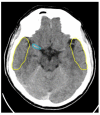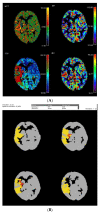How to Improve the Management of Acute Ischemic Stroke by Modern Technologies, Artificial Intelligence, and New Treatment Methods
- PMID: 34072071
- PMCID: PMC8229281
- DOI: 10.3390/life11060488
How to Improve the Management of Acute Ischemic Stroke by Modern Technologies, Artificial Intelligence, and New Treatment Methods
Abstract
Stroke remains one of the leading causes of death and disability in Europe. The European Stroke Action Plan (ESAP) defines four main targets for the years 2018 to 2030. The COVID-19 pandemic forced the use of innovative technologies and created pressure to improve internet networks. Moreover, 5G internet network will be helpful for the transfer and collecting of extremely big databases. Nowadays, the speed of internet connection is a limiting factor for robotic systems, which can be controlled and commanded potentially from various places in the world. Innovative technologies can be implemented for acute stroke patient management soon. Artificial intelligence (AI) and robotics are used increasingly often without the exception of medicine. Their implementation can be achieved in every level of stroke care. In this article, all steps of stroke health care processes are discussed in terms of how to improve them (including prehospital diagnosis, consultation, transfer of the patient, diagnosis, techniques of the treatment as well as rehabilitation and usage of AI). New ethical problems have also been discovered. Everything must be aligned to the concept of "time is brain".
Keywords: artificial intelligence; diagnosis; ischemia; ischemic stroke; management; plan; rehabilitation; robotics; stroke; treatment.
Conflict of interest statement
J.F.: Research support: BMBF, BMWi, DFG, EU, Acandis, Medtronic, Microvention, Stryker. Executive functions: University Medical Center Hamburg-Eppendorf, Eppdata GmbH. Stock: Tegus. Consultancy: Acandis, Codman, Cerenovus, Medtronic, Microvention, Penumbra, Route 92, Stryker, Transverse Medical; D.B. (Daniel Behme): None regarding the content of the article, consultant for Phenox, Balt, Vesalio and Acandis; I.V.: Speakers honoraria: Medtronic; K.Z., A.K., L.M., D.B.(Deniz Bulja), J.C., A.A.C., V.D.R., J.-C.G., J.H., O.K.-H., Ö.K., J.L., and E.P. declare no conflict of interest. The funders had no role in the writing of the manuscript.
Figures






Similar articles
-
Your Robot Therapist Will See You Now: Ethical Implications of Embodied Artificial Intelligence in Psychiatry, Psychology, and Psychotherapy.J Med Internet Res. 2019 May 9;21(5):e13216. doi: 10.2196/13216. J Med Internet Res. 2019. PMID: 31094356 Free PMC article. Review.
-
Trial design and reporting standards for intra-arterial cerebral thrombolysis for acute ischemic stroke.Stroke. 2003 Aug;34(8):e109-37. doi: 10.1161/01.STR.0000082721.62796.09. Epub 2003 Jul 17. Stroke. 2003. PMID: 12869717
-
Birth of Industry 5.0: Making Sense of Big Data with Artificial Intelligence, "The Internet of Things" and Next-Generation Technology Policy.OMICS. 2018 Jan;22(1):65-76. doi: 10.1089/omi.2017.0194. Epub 2018 Jan 2. OMICS. 2018. PMID: 29293405 Review.
-
Tele-robotics and artificial-intelligence in stroke care.J Clin Neurosci. 2020 Sep;79:129-132. doi: 10.1016/j.jocn.2020.04.125. Epub 2020 Aug 5. J Clin Neurosci. 2020. PMID: 33070881 Review.
-
Converging Robotic Technologies in Targeted Neural Rehabilitation: A Review of Emerging Solutions and Challenges.Sensors (Basel). 2021 Mar 16;21(6):2084. doi: 10.3390/s21062084. Sensors (Basel). 2021. PMID: 33809721 Free PMC article. Review.
Cited by
-
Optimization of Radiology Diagnostic Services for Patients with Stroke in Multidisciplinary Hospitals.Mater Sociomed. 2024;36(2):160-172. doi: 10.5455/msm.2024.36.160-172. Mater Sociomed. 2024. PMID: 39712327 Free PMC article. Review.
-
The Route of Motor Recovery in Stroke Patients Driven by Exoskeleton-Robot-Assisted Therapy: A Path-Analysis.Med Sci (Basel). 2021 Oct 26;9(4):64. doi: 10.3390/medsci9040064. Med Sci (Basel). 2021. PMID: 34842770 Free PMC article.
-
Artificial intelligence in ischemic stroke images: current applications and future directions.Front Neurol. 2024 Jul 10;15:1418060. doi: 10.3389/fneur.2024.1418060. eCollection 2024. Front Neurol. 2024. PMID: 39050128 Free PMC article. Review.
-
Artificial intelligence in stroke risk assessment and management via retinal imaging.Front Comput Neurosci. 2025 Feb 17;19:1490603. doi: 10.3389/fncom.2025.1490603. eCollection 2025. Front Comput Neurosci. 2025. PMID: 40034651 Free PMC article. Review.
-
Automatic theranostics for long-term neurorehabilitation after stroke.Front Aging Neurosci. 2023 May 16;15:1154795. doi: 10.3389/fnagi.2023.1154795. eCollection 2023. Front Aging Neurosci. 2023. PMID: 37261267 Free PMC article. No abstract available.
References
-
- Benjamin: E.J., Virani S.S., Callaway C.W., Chamberlain A.M., Chang A.R., Cheng S., Chiuve S.E., Cushman M., Delling F.N., Deo R., et al. Heart disease and stroke statistics-2018 update: A report from the american heart association [published correction appears in circulation. Circulation. 2018;137:e67–e492. doi: 10.1161/CIR.0000000000000558. - DOI - PubMed
-
- Feigin V.L., Forouzanfar M.H., Krishnamurthi R., Mensah G.A., Connor M., Bennett D.A., Moran A.E., Sacco R.L., Anderson L., Truelsen T., et al. Global and regional burden of stroke during 1990-2010: Findings from the Global Burden of Disease Study 2010. Lancet. 2014;383:245–254. doi: 10.1016/S0140-6736(13)61953-4. - DOI - PMC - PubMed
-
- Mozaffarian D., Benjamin E.J., Go A.S., Arnett D.K., Blaha M.J., Cushman M., Das S.R., De Ferranti S., Després J.-P., Fullerton H.J., et al. Heart disease and stroke statistics-2016 update: A report from the american heart association. Circulation. 2016;133:e38–e360. doi: 10.1161/CIR.0000000000000350. - DOI - PubMed
Publication types
LinkOut - more resources
Full Text Sources

